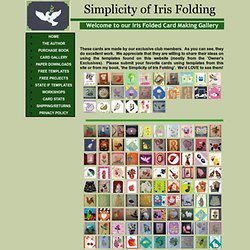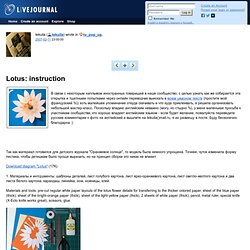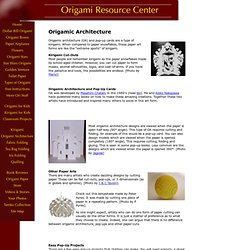

Origami Kirigami Paper Art. Pop-Up Paper Craft Weds Japanese Tradition And Modern Architecture. In architectural criticism (mainly from the early '90s), the term “paper architecture” is typically used to disparage architects whose schemes are so unrealistic they’re unbuildable.

The phrase is also applied to the emergence of “paperless,” computer-driven design studios. A third, less polemical definition comes from Japan, where a Tokyo Institute of Technology architecture professor named Masahiro Chatani developed a technique for cutting and folding single pieces of paper into elaborate 3-D models, drawing on traditional Japanese card making and pop-up books. Chatani died in 2008, but a number of artists have continued his Origamic work, among them, Dutch artist Ingrid Siliakus.
Siliakus studied Chatani’s work in pattern books for years before attempting her first cut, but since then, her work has appeared in dozens of exhibitions and on the covers of the New York Times Style Magazine and Wallpaper*. She begins by sketching each layer individually, as you would a drawing. Origamic Architecture. Tadashi Mori´s videos. ★ Origamic Architecture Instructions & Free Kirigami Templates ★ Architectural origami is the art of paper cutting to create 3D buildings – from just one sheet of paper!

The designs range from the simple to the exceptionally intricate, and the subject matter can be anything from a whole city to a famous landmark or even your own house. This page will focus on 90° pop-up buildings and detailed shapes, where the 3D design emerges and is fully visible when the paper is folded to an angle of 90 degrees. That means that this technique is well suited to making impressive pop-up cards as well – although you won’t be mass producing these for all your colleagues at Christmas (unless you start in January!)
Below you will find inspirational examples of origami artist’s work, advice for creating your own artwork, plus free online downloads. After saving the free templates to your computer, print them out and cut and fold along the lines. If the lines are straight, use a steel ruler alongside your craft knife to get neat, perfectly straight cuts. Takumi's Studio. ハンドメイド ペーパークラフト クラブ ポップアップカードを作ろう! Origamic Architecture: Stunning Sculptures Cut Out of Paper. In the Japanese paperfolding art of origami, cutting the paper is frowned upon.

But in 1981, Masahiro Chatani, professor of Architecture at Tokyo Institute of Technology proved that papercutting could indeed produce stunning pieces of art. Along with his colleague Keiko Nakazawa, Chatani developed Origamic Architecture, a variation of kirigami (itself a variation of origami where cuts were allowed), where you only needed an X-acto knife and a ruler to create complex 3-dimensional structures out of a single sheet of paper. Origamic Architecture sculptures range from (the relatively simple) geometric patterns to famous buildings' facades. It's like 3-D pop-up greeting cards, but much, much more complex. While looking at the examples below, keep this in mind: everything's done with the simple cuts of the knife.
Simple cuts can result in stunning geometric shapes - from Gerry Stormer's gallery (click the artist's name for more): Stairs to Paradise by Gerry Stormer (Photo: Carl Uetz) Origami おりがみ 折紙. Ein magisches Projekt – A Magic Project. Origamic Architecture Kirigami Cards for Free ! At the beginning Origamic Architecture is a paper folding and cutting art created in the early 80's by Masahiro Chatani (a Japanese architect).

It consists of a simple sheet of paper that the artist cuts and folds to create a pop-up shape as the card is opened. The OA cards frequently represent famous buildings or geometrical figures but there are many other possibilities. M.Chatani and Keiko Nakazawa have published many of early books on this Art. L'Architecture Origamique est un art du pliage-découpage initié au début des années 80 par Masahiro Chatani (un architecte japonais).
Featured | Coup de Projecteur. CardGallery. <span><a target="_self" href="/index.html">HOME</a><br /><a target="_self" href="/author.html">THE AUTHOR</a><br /><a target="_self" href="/products.html">PURCHASE BOOK</a><br /><a target="_self" href="/CardGallery.html">CARD GALLERY</a><br /><a target="_blank" href="/Free-Downloads.html">PAPER DOWNLOADS</a><br /><a target="_self" href="/freepatterns.html">FREE TEMPLATES</a><br /><a target="_self" href="/projects.html">FREE PROJECTS</a><br /><a target="_blank" href="/State-Templates.html">STATE IF TEMPLATES</a><br /><a target="_self" href="/workshops.html">WORKSHOPS</a><br /><a target="_self" href="/greetingcardstats.html">CARD STATS</a><br /><a target="_blank" href="/shipping.html">SHIPPING/RETURNS</a><br /><a target="_self" href="/PrivacyPolicy.html">PRIVACY POLICY</a></span> These cards are made by our exclusive club members.

As you can see, they do excellent work. Welcome to our Iris Folded Card Making Gallery. Creaviva - Kirigami. Ru_pop_up: Lotus: instruction. Так как материал готовился для детского журнала "Оранжевое солнце", то модель была немного упрощена.

Точнее, чуток изменила форму пестика, чтобы детишкам было проще вырезать, но на принцип сборки это никак не влияет. Download diagram "Lotus" (17K) 1. Материалы и интсрументы: шаблоны деталей, лист голубого картона, лист ярко-оранжевого картона, лист светло-желтого картона и два листа белого картона; карандаш, линейка, нож, ножницы, клей. Materials and tools: pre-cut regular white paper layouts of the lotus flower details for transferring to the thicker colored paper, sheet of the blue paper (thick); sheet of the bright-orange paper (thick), sheet of the light-yellow paper (thick), 2 sheets of white paper (thick); pencil, metal ruler, special knife (X-Ecto knife works great), scissors, glue. 2. Using paper layouts cut out all details from the thicker colored paper sheets (please see the photos). 3. 4. 5. 6. 7. 8. 9. DIY Instructions for Beginners ★ As a beginner to pop-ups, the V-fold and box fold techniques are likely to be the ones you will be using most.

Here is a list of the most common mechanisms used in pop-up creation: - V-Folds: These can be cut and folded directly into the main piece of card, or can be created by adding an additional section of card for the pop-up shape. V-folds are very versatile and are where, simply enough, a V shape is created with the pop-up section. It’s either the folds made in the base card, or the connections between the separate pop-up section and the base card, which produce the ‘V’ shape when the base card is open. This is the difference from box folds (see below), which are created using parallel horizontal or vertical folds rather than making use of V shaped angles. . - Box folds (also called Interval Stands or Layers): These are created with vertical or horizontal folds and cuts in order to produce 3D box shapes. . - Mouth folds: Mostly used to create the effect of an opening and closing mouth. Geometrische Objekte. Peter Dahmen · Grafikdesign. Origamic Architecture, pop-up cards and other kirigami.
Origamic architecture (OA) and pop-up cards are a type of kirigami.

When compared to paper snowflakes, these paper art forms are like the “extreme sports” of kirigami. Kirigami Cut-Outs Most people will remember kirigami as the paper snowflakes made by school-aged children. However, you can cut paper to form masks, animal silhouettes, logos, and coat-of-arms. If you have the patience and tools, the possibilities are endless. [Photo by Marivi] Origamic Architecture and Pop-Up Cards OA was developed by Masahiro Chatani in the 1980’s (read bio). Have published many books on how to make these amazing creations.